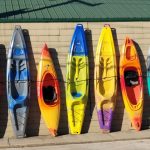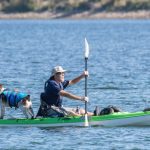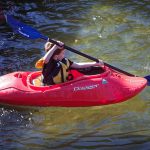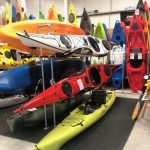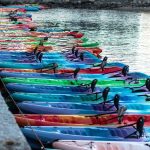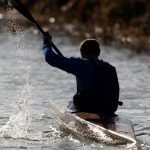This is our list of industry-leading kayak companies in the US. We also have detailed reviews of most brands and their model lines.
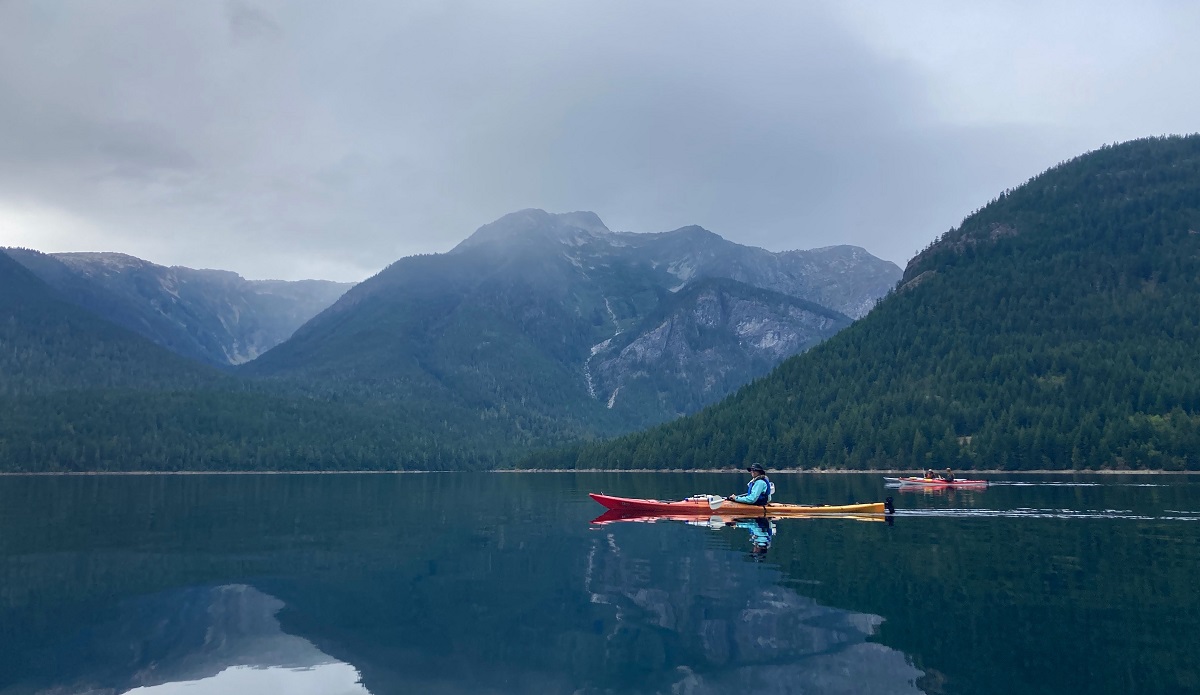
Getting ready to cross that huge lake in a kayak? Here’s our list of the best kayaks for lakes and some tips for choosing the right kayak for the mission. Our pick as the best overall kayak for lakes is Wilderness Systems Pungo 120
Lake kayaking is truly an amazing way to spend your summer—and a great option for beginners to get started.
Whether you’re paddling along the shore, heading out for some kayak fishing, or planning on long-haul paddling across the entire lake, there are so many ways you can enjoy the many lovely lakes in your area.
In this article, we’re going to take a closer look at the best kayaks for lakes, in the many, many variations, as well as all the critical information you need to know to be a truly badass lake kayaker.
Get ready for a deep dive into one of the simplest, most widely available, and most you-friendly forms of kayaking around!
As an affiliate of Amazon and other retailers, we may earn a small commission when you buy via our links, at no additional cost to you. Thank you!
Quick Answer: The Best Lake Kayak for You
Don’t have time to read the whole post? Don’t worry! Here’s our list of the best kayaks for lakes we recommend for you to consider:
Best Overall: Wilderness Systems Pungo 120
Best Budget: Intex Excursion Pro
Best Single Recreational: Dagger Zydeco 11
Best Tandem Recreational: Wilderness Systems Pamlico 135
Best Fishing: Old Town Topwater 106
Best Single Inflatable: Advanced Elements AdvancedFrame
Best Tandem Inflatable: Sea Eagle 370
Best Kids’: Lifetime Wave
Best Hybrid: Isle Switch 2 in 1
Best Touring: Eddyline Fathom
Comparison Table: Best Kayaks for Lakes
| Model | Specs | Where To Buy |
Wilderness Systems Pungo 120 | Size: 12’2” x 29″ Weight: 49 lbs Capacity: 325 lbs | Amazon |
Intex Excursion Pro | Size: 12’7” x 36″ Weight: 39 lbs Capacity: 400 lbs | Amazon |
Dagger Zydeco 11 | Size: 11’2” x 27.8″ Weight: 48 lbs Capacity: 325 lbs | Amazon |
Wilderness Systems Pamlico 135 | Size: 13’ 6” x 31″ Weight: 72 lb Capacity: 500 lb | Amazon |
Old Town Topwater 106 | Size: 13’ 6” x 31″ Weight: 72 lb Capacity: 500 lb | Eco Fishing Shop |
Advanced Elements AdvancedFrame | Size: 10’5” x 32″ Weight: 36 lbs Capacity: 300 lbs | Amazon |
Sea Eagle 370 | Size: 12’6” x 33.8” Weight: 33 lbs Capacity: 650 lbs | Amazon |
 Lifetime Wave | Size: 6’ x 24″ Weight: 18 lbs Capacity: 130 lbs | Amazon |
Isle Switch 2 in 1 | Size: 11’6″ x 35.5″ Weight: 19 lbs Capacity: 425 lbs | Amazon |
Eddyline Fathom | Size: 16′ 6″ x 22″ Weight: 50 lbs Capacity: 340 lbs | Delaware Paddle Sports |
The 10 Best Lake Kayaks
Best Overall: Wilderness Systems Pungo 120

Length: 12’2” (371 cm)
Width: 29″ (74 cm)
Weight: 49 lbs (22 kg)
Weight Capacity: 325 lbs (147 kg)
Whether you’re a total kayaking newbie or an experienced pro, you’ll find this Wilderness recreational kayak is a great match for your paddling style. It’s built tough, with a long, sleek hull that offers amazing speed and tracking, all without sacrificing maneuverability. Thanks to its spacious cockpit, you’ll be comfortable sitting in this bad boy all day long.
Comfort is guaranteed thanks to the knee padding, the adjustable footrests, and the 3D foam-padded seat with its adjustable design. There’s not quite as much storage space as you might like for an overnight or multi-day trip, but you can still haul enough supplies to set up camp in the one rear cargo compartment, and its 325-pound weight capacity can handle a large paddler + plenty of gear.
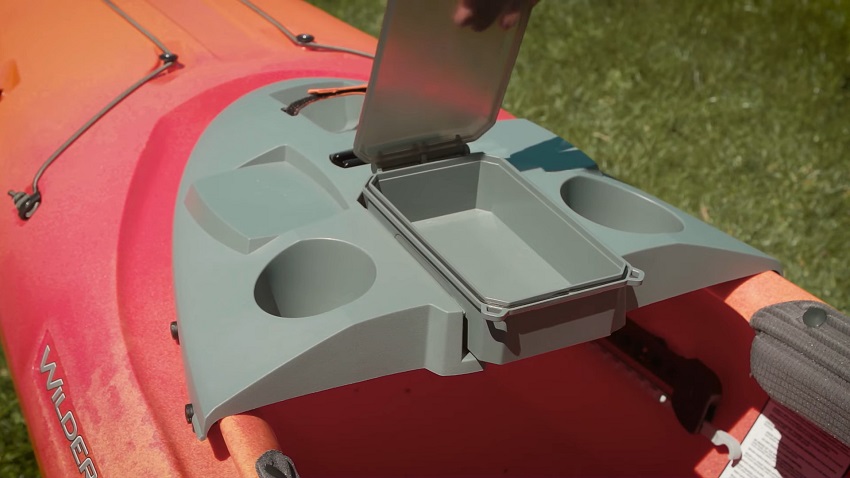
It’s definitely on the heavier side—nearly 50 pounds—and can be a bit long and unwieldy to haul on your own, but once it hits the water, you’re in for a very smooth ride. (Note: If you need more carrying capacity, consider upgrading to the Pungo 125.)
Best Budget: Intex Excursion Pro

Length: 12’7” (383.5 cm)
Width: 36″ (91cm)
Weight: 39 lbs. (17.7 kg)
Capacity: 400 lbs. (180 kg)
If you want a quality kayak on a tight budget, this is a great choice. The tandem kayak is one of the most affordable on the market, but with space for two paddlers and a better-than-average weight capacity, it’s enough that you can transport plenty of gear for an overnight camping trip.
Compared to other inflatable kayaks, this one is built for speed, with reinforcements at the bow and stern that will keep it tracking straight and slicing through even choppy water. There will be a bit of struggle against high winds (a common problem with inflatables), so it’s best to use on those calm, sunny days when the lake is flat.

The 3-ply PVC laminate and polyester core used to build the kayak is sturdy enough you’ll be able to use it for years of regular exploration without worrying about punctures, scrapes, or damage. It’s definitely heavy compared to other inflatable kayaks (as you’ll see below), but it’s still beautifully compact and folds down small enough fit into the trunk of pretty much any sedan or minivan.
Best Single Recreational: Dagger Zydeco 11

Length: 11’2” (340 cm)
Width: 27’8″ (70 cm)
Weight: 48 lbs (22 kg)
Capacity: 325 lbs (147 kg)
This is no ordinary recreational kayak! At 11 feet, it’s long enough to be stable and speedy, but tracks straighter and handles better than most 10-footers. It’s also comfortable to sit in for long hours, thanks to the roomy cockpit, as well as the knee pads, adjustable footrest, and adjustable seat (with its extra-high back for better lumbar support). It also has a decent weight capacity and ample storage space for all the critical gear you want to haul with you.
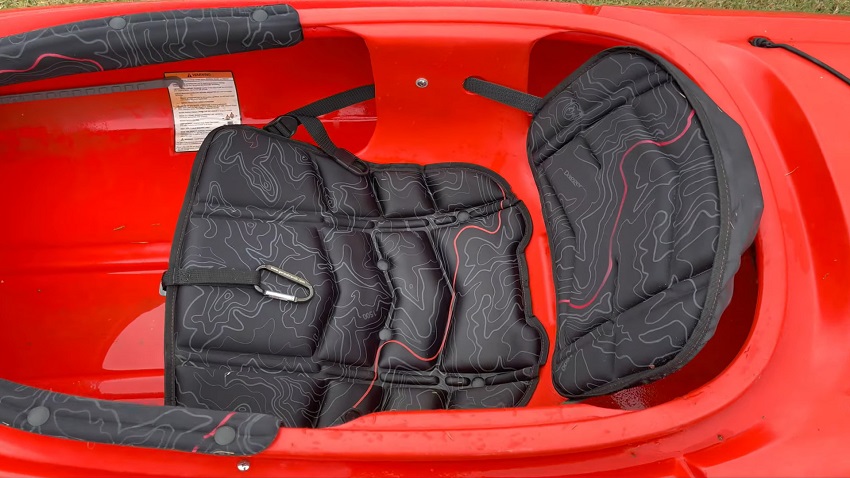
The stern bulkhead has a hatch that keeps your gear dry and keeps water out, and the bungee cords on the bow give you a convenient place to stash a dry bag or any waterproof backpacks you want to take with you. Thanks to its V-shaped hull, it can handle even choppier waters, but will still be comfortable to take on a flat lake.
It’s far from the lightest kayak on our list, but the extra weight is an acceptable trade-off for a sturdy hull that will last you for years of weekly use.
Best Tandem Recreational: Wilderness Systems Pamlico 135

Length: 13’ 6” (411 cm)
Width: 31″ (79 cm)
Weight: 72 lb (32.7 kg)
Capacity: 500 lb (227 kg)
If you’re looking for a tandem recreational kayak ideal for lake paddling, you won’t find options better than this lovely Wilderness Systems kayak. Though it’s built in the recreational kayak design, it handles almost as well as a touring kayak, with excellent tracking and the ability to reach some pretty impressive speeds.
At 72 pounds, it’s on the heavier side even for a hard-shell kayak, but it’s definitely worth it for the 500-pound weight capacity. In addition to the thigh pads, the kayak comes with two Phase 3 AirPro seats, which are easily adjusted to the perfect position for your multi-hour or overnight paddling trip. Plus, if you ever want to hit the water on your own, the dual-seating kayak can be converted into a solo configuration with just a few minutes of effort.
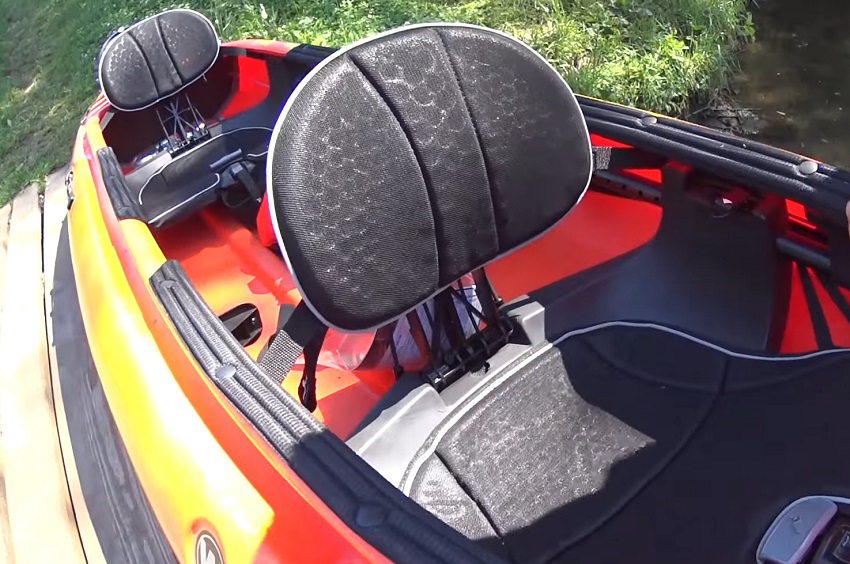
Best Fishing: Old Town Topwater 106

Length: 10’6” (3.2 m)
Width: 34.5″ (87.6 cm)
Weight: 73 lb (33.1 kg)
Capacity: 440 lbs (199.5 kg)
This Old Town kayak strikes a perfect balance between affordability and excellence. Despite its lower-than-average price tag (for a fishing kayak), it comes with a number of features— a watertight bow storage compartment complete with drain, mid-deck scupper holes that can fit a transducer cable to mount a fishfinder on the universal transducer mounting plate secured to the hill, a stand-assist strap, adjustable footrests, gear tracks on both gunnels, foam pads on the deck to offer excellent traction when standing, three rod holders, a paddle holder, and a tank well storage area.
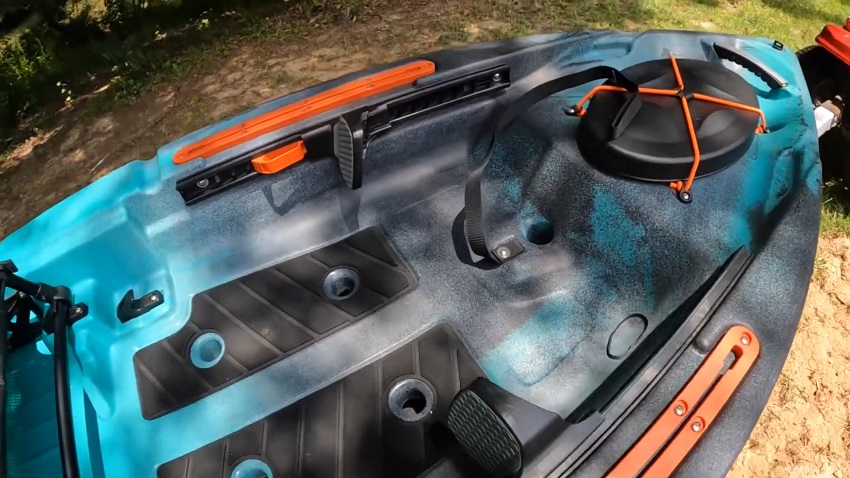
The kayak manages to have good primary and secondary stability (not common, even with fishing kayaks) and can easily be used standing up and sitting down. Despite its buoyancy, it still handles well and responds to your paddle strokes with speed.
At 73 pounds, it’s definitely heavy (even for a fishing kayak), but you’ll love the 440-pound weight capacity and the spacious design.
Best Single Inflatable: Advanced Elements AdvancedFrame
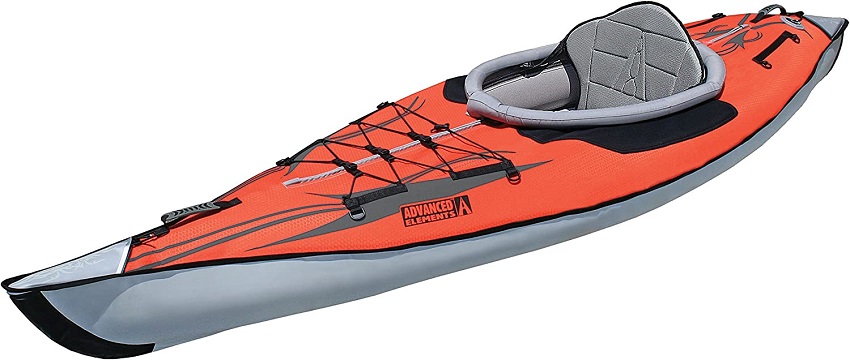
Length: 10’5” (317.5 cm)
Width: 32″ (81.3 cm)
Weight: 36 lbs (16 kg)
Capacity: 300 lbs (136 kg)
This inflatable kayak has all the light weight and buoyancy of your standard inflatable, but a few additional design features that helps it handle more like a hardshell kayak. The 3-layer PVC material is tough but not overly heavy, and when inflating, stretches over rigid aluminum ribs in the stern and bow that will slice through the water. The result: a surprisingly speedy kayak that tracks straight and keeps you on-course even in high winds.
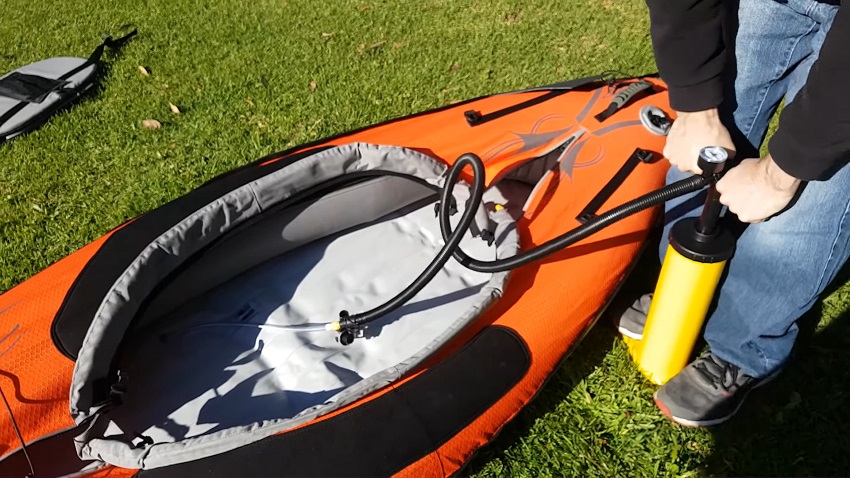
The aluminum ribs are pre-installed, so there’s no need to assemble anything—just inflate and enjoy. The addition of the metal doesn’t add too much to the kayak’s weight; it’s still light enough you can load and unload it easily and portage from lake to lake.
This kayak doesn’t have the best weight capacity, but it’s worth using if you want an inflatable that will zip across the lake or navigate the tight twists and turns of creeks and inlets. Plus, it’s one of the most comfortable inflatable kayaks you’ll ever sit in.
Best Tandem Inflatable: Sea Eagle 370
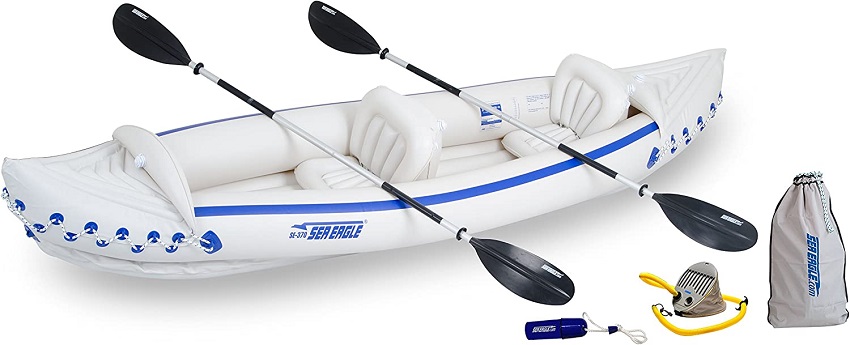
Length: 12’6” (381 cm)
Width: 33.8″ (86 cm)
Weight: 32 lbs (15 kg)
Capacity: 650 lbs (294.4 kg)
For those who want a lightweight, ultra-portable tandem kayak, this is the choice for you. At 32 pounds, it weighs less than most of the single hardshell kayaks on our list, and it has handles so two people can carry it—essentially cutting that already minimal weight in half. By contrast, it’s got an impressive weight capacity of up to 650 pounds, and space enough to haul three paddlers (or two paddlers + child or pet).
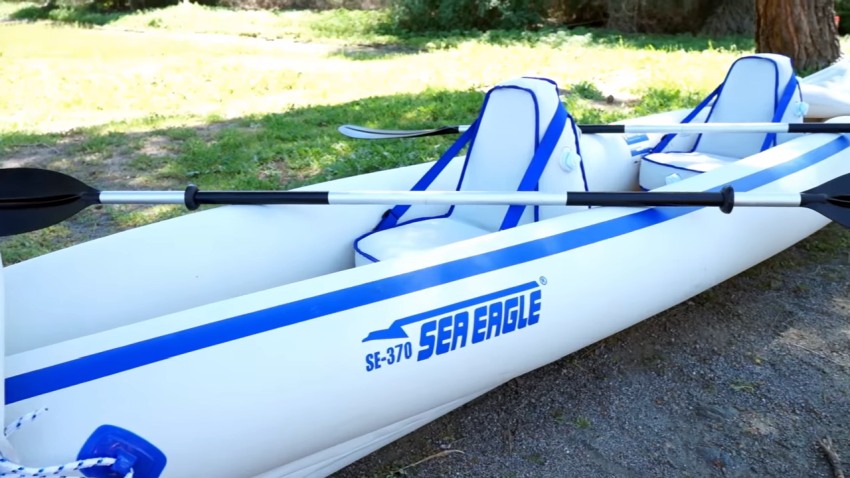
When folded down small, though, it fits into the trunk of your vehicle. It’s easy to inflate, sturdily built, and features surprisingly comfortable and supportive seats (compared to other inflatables). Plus, your purchase includes the two paddles, a foot pump, and built-in skegs that make handling the kayak a breeze.
For the price, you won’t find many more affordable tandem kayaks, but don’t let the low cost fool you. Sea Eagle builds their inflatables tough enough that they’ll deliver years of regular use.
Best Kids’: Lifetime Wave
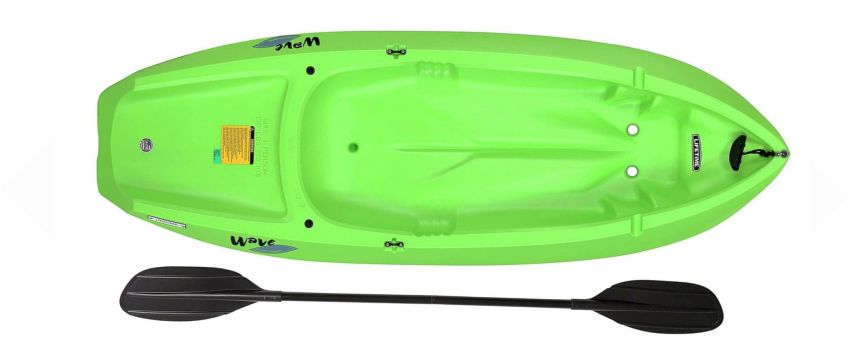
Length: 6’ (183 cm)
Width: 24″ (61 cm)
Weight: 18 lb (8.2 kg)
Capacity: 130 lb (59 kg)
Get ready for a kayak that not even your wild and over-active kids can break. Built from ultra-tough high-density polyethylene, the kayak is tough enough that it will endure even the rowdiest paddling and grinding/being dragged over rocks and sand.
What makes this a truly great lake kayak for kids, though, is its primary stability. They can use it as a diving platform and scramble on and off the kayak without flipping it over, and even if it capsizes, it’s easily righted and drained.
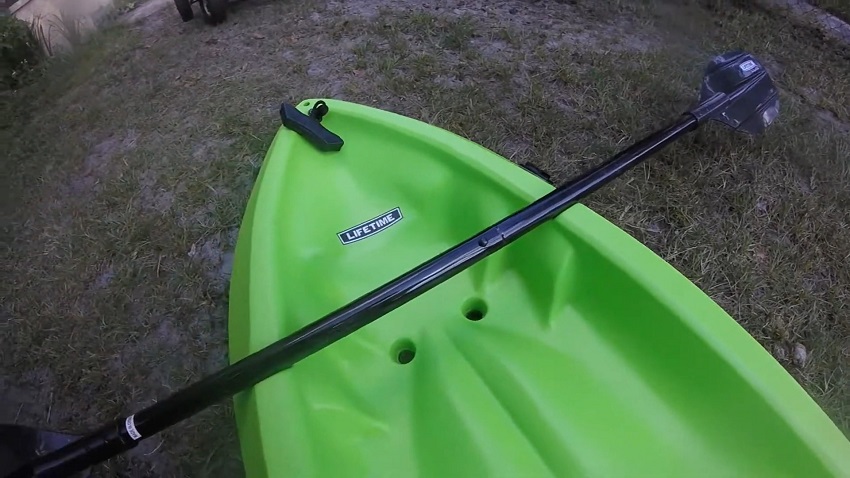
The multiple footrests will accommodate your kids as they grow, allowing them to sit in the position that feels most comfortable. Add to that the molded finger handles for easy carrying, the swim step that makes re-mounting the kayak from the water easy, and the provided child-sized paddle, and you’ve got a perfect first kayak for your younger paddlers.
Best Hybrid: Isle Switch 2 in 1
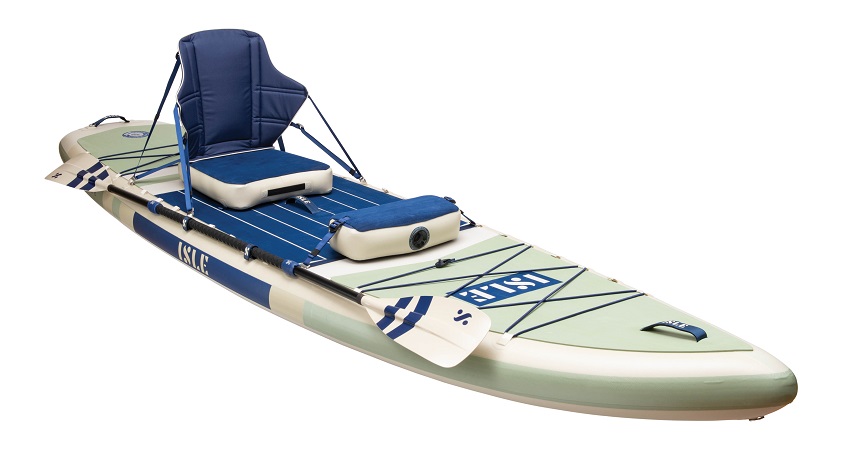
Length: 11’ 6” (3.5 m)
Width: 35.5 ” (90 cm)
Weight: 19 lbs (8.6 kg)
Capacity: 425 lbs (193 kg)
The Isle Switch 2-in-1 is a hybrid paddleboard and kayak that will allow you to paddle the way you feel most comfortable. The inflatable paddleboard “base” is incredibly sturdy, built using drop-stitching and an ultra-tough fabric that can shrug off impact and abrasion with ease. Plus, the foam padding on the deck will give you easy traction to stand on when you’re in “paddleboard mode”.
When the time comes to sit and paddle, though, you’ll find the provided seat is comfortable and offers decent support, while the inflatable footrest will give you something solid to push against with each stroke. Thanks to the patented ISLE-LINK connection, you can easily adjust the placement of the seat according to what feels most comfortable for your specific size.
You’ll love how stable it feels both sitting and standing, and it’s an excellent paddleboard kayak hybrid for zipping across a lake or floating down a lazy river under the bright sun.

Best Touring: Eddyline Fathom

Length: 16′ 6″ (503 cm)
Width: 22″ (55.8 cm)
Weight: 50 lbs (22.5 kg)
Capacity: 340 lbs (154 kg)
If you plan to travel long distances across vast lakes, you’ll want the Eddyline Fathom as your kayak of choice. Built from ABS plastic, it’s constructed with a sleek, long hull that will slice through the water at impressive speeds, tracking straight and keeping you on course all day long. It’s certainly not the most agile kayak (no touring kayaks are, really), but it will be an amazing choice for covering dozens of miles in a single day.
The V-shaped hull, hard chines, and low, balanced rocker makes this kayak an absolute dream for long-distance paddling. It’s got a drop-down skeg that will make steering a breeze, and its high secondary stability makes it well-suited to wind-whipped open water. Thanks to the two large bow and stern hatches, you’ve got ample storage space for all your gear, and a slightly-better-than-average weight capacity.
Convenient features include: recessed deck-top fittings, retractable handles, adjustable seat with excellent back support, adjustable footrests, and reflective deck lines around the edge. It’s the perfect choice for your next cross-lake (and open-water) adventure!
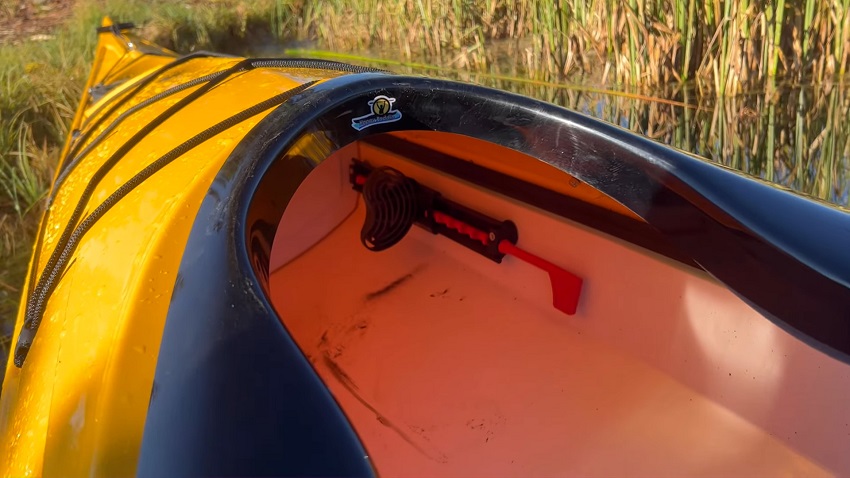
The Ultimate Guide to Lake Kayaking
Lakes come in all shapes and sizes. Some, like the American Great Lakes, are vast expanses of water that are almost like mini-seas in their own right. Others are so small you can paddle across them in an hour.
What makes lake kayaking so great is that it’s very beginner-friendly.
If you’ve never been out on a kayak before, the lake is the perfect place for you to dip your paddle for the first time because of how calm the waters usually are.
On a sunny day with minimal wind, lakes will be glassy smooth with only gentle currents—optimal conditions for paddling around and getting the hang of using a kayak.
It’s always the best place to get started learning the ropes of kayaking before heading out on a fast-flowing river or the wave-churned ocean. Most newbies get their start lake kayaking first, then upgrade for faster-paced, more intense adventures down the line.
How Lake Kayaking is Different
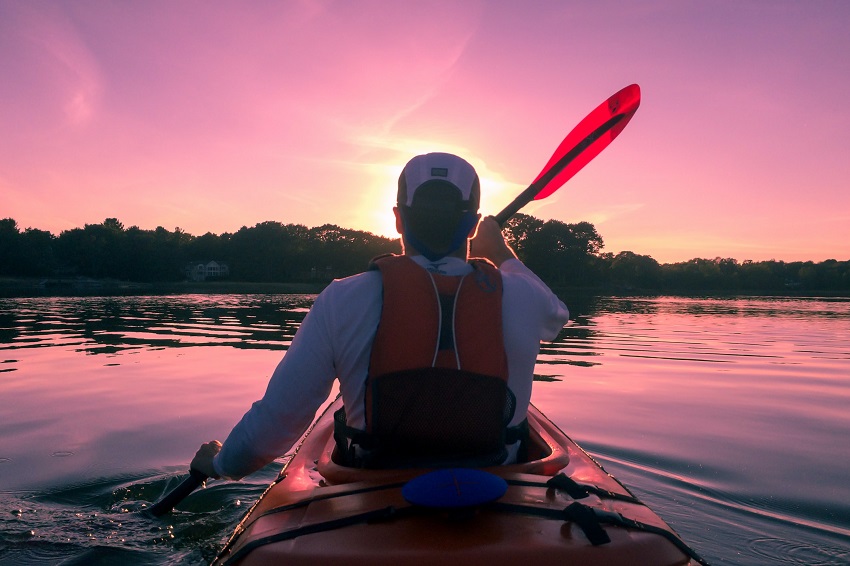
What makes lake kayaking different from other forms of kayaking?
Distances
When you’re paddling down a river, you’re traveling a specific distance along a pre-set route (as guided by the river).
But lake kayaking involves far less specific distances with no restrictions on the route.
You can paddle around the lake, across the lake, or pretty much however you want. Because it’s a single, enclosed body of water, the distances are a bit harder to calculate.
Open water
With river kayaking, you’re paddling down a water route with two riverbanks set close together. But with lake kayaking, you’re essentially headed out across “open” water.
It’s not quite the same as the ocean, in that there are no tidal flows or vast ocean currents. But you could easily be an hour of hard paddling away from shore—and safety or rescue in case of capsize—when out in the middle of even a mid-sized lake.
Exposure to wind
The farther you paddle away from the lake shore, the more exposed you are to winds—just like when out on the open ocean.
Rivers are often bordered by trees and landforms (cliffs, hills, etc.) that act as wind-breaks, so you can paddle for hours and never feel a gust. But out on the lake, there’s nothing to stop the wind from pushing you off-course.
If you’re paddling into the wind, you may find the effort is far more challenging than you expected.
Currents
Yes, there are currents on a lake. Often, the larger the lake, the stronger the current.
When a river feeds into one side of a lake and another river flows out of another side, the water naturally flows between the intake and outlet points, creating a current (ranging from gentle to strong, depending on the river’s flow).
The wind and even the bed of the lake itself can also create currents, to the point where it can actually make paddling difficult.
Choppiness
Lakes can be surprisingly unpredictable for choppiness. On a river, the choppiness is controlled by the flow of the river, the water height, and obstacles under the water’s surface.
On the ocean, you know you’re going to have to deal with waves, but the wind can make things tricky if it whips up the ocean’s surface and creates larger waves and stronger currents. Lakes are more like oceans in the sense that the wind will cause choppiness and turbulence.
Because there are no wind-breaks out far from the shore, what started out as a calm, relaxing paddle can quickly turn challenging and even dangerous if the wind picks up.
The good news is that a bit of preparation—including choosing the right kayak—can help you to be prepared to handle any challenges your lake/s may throw at you!
What Types of Kayaks are Best for Lakes?
There are basically four types of kayaks you’ll want to consider when heading out to do some lake kayaking:
Recreational Kayaks
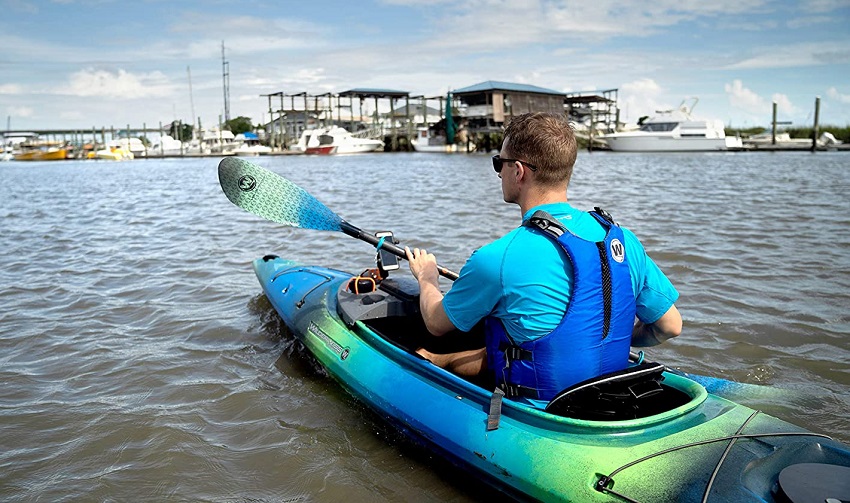
Recreational kayaks tend to handle better on the flat, calm waters of a lake (you’ll understand why when you read the “Stability” section below). They’re great for beginners because they’re:
A) widely available,
B) designed to be newbie-friendly to handle,
C) are one of the least expensive options.
Recreational kayaks may not go as fast as a touring kayak and will definitely be better for staying closer to shore, but they’re a great starting point for anyone looking to get out on the lake.
Touring Kayaks
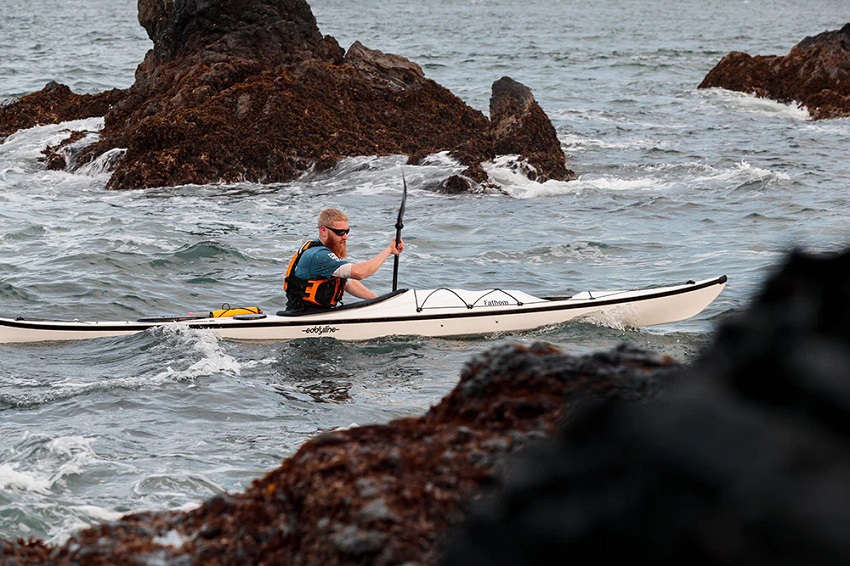
If you’re looking at paddling across or around a large lake—for example, the American Great Lakes or Canada’s Great Slave Lake—you’ll want a kayak built for speed and covering long distances.
Enter the touring kayak: a lighter, sleeker, longer kayak capable of slicing through currents and handling windy/choppy conditions.
Touring kayaks are bigger because they’re constructed for multi-day use, offering more storage space and a faster-moving design. They also tend to be pricier, though.
Fishing Kayaks
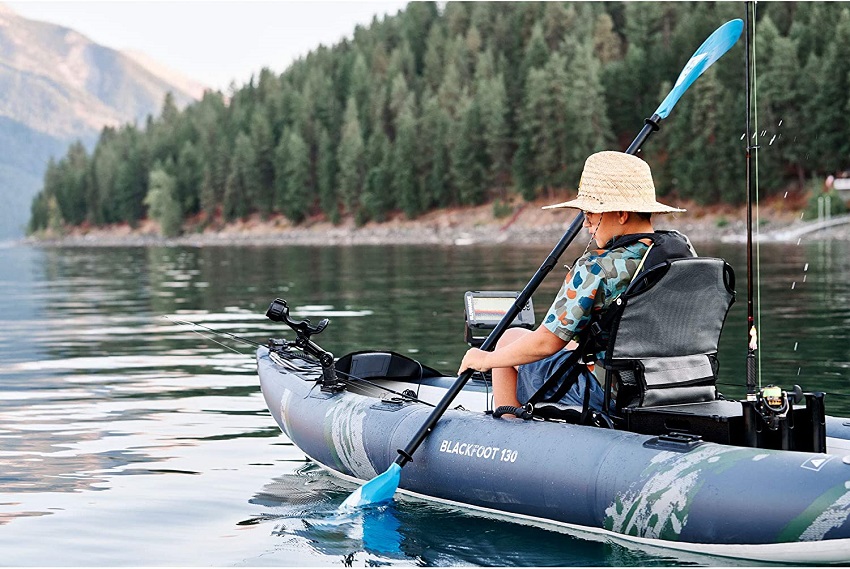
Fishing kayaks are the perfect option for anyone who wants to paddle around a lake and throw out a fishing line.
Generally a “sit-on-top” design (see below), fishing kayaks are very stable and offer comfortable, open seating that allows you to move and shift around to stay comfortable over long hours of fishing and paddling.
They definitely aren’t the fastest choice—they’re designed to serve essentially as a mobile fishing platform—and tend to be on the heavy side, but they are a great option for anglers who prefer stability over speed.
If you need to cover large distances in a fishing kayak, consider getting a pedal-driven or even a motorized kayak. You won’t regret it.
Inflatable Kayaks
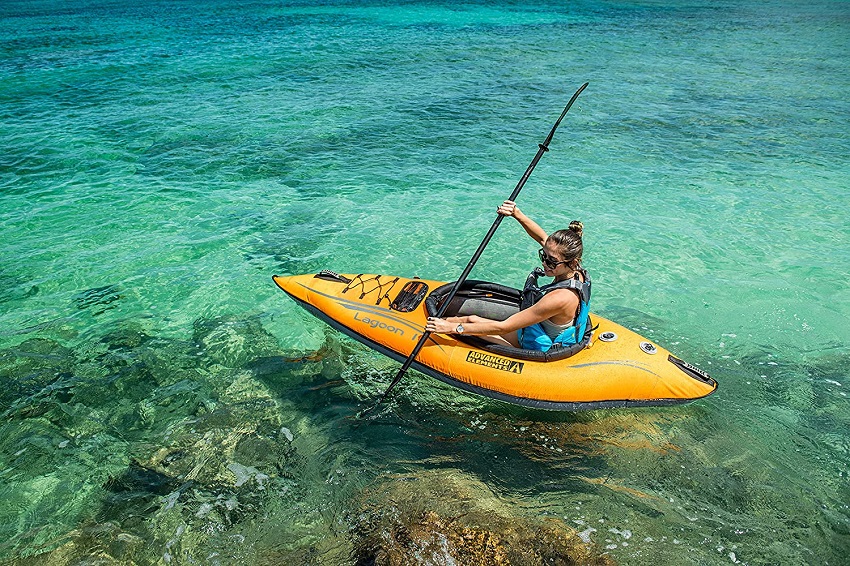
Many inflatable kayaks are built specifically for lake use. They have very high primary stability (see the “Stability” section below to understand what exactly this means) and buoyancy because they’re filled with air. They’re also fairly hard to capsize and weigh very little.
Unfortunately, because they sit high on the water, they’re easily blown off-course by high winds. You’re better off using them on calm lakes with minimal currents on days with as little wind as possible.
What to Consider in a Good Lake Kayak
If you’re looking for the best kayaks for lakes, here are the factors you should be considering:
Design
There are two “basic” designs to consider:
1. Sit-in kayaks, which involve an enclosed cockpit with a seat that places you just below the water level and high sides to keep the water from spilling into the kayak.
Typically, touring and recreational kayaks will feature this design.
Sit-in kayaks tend to be faster, less likely to be blown off-course by the wind, and offer more waterproof storage space.
If you’re crossing long distances or transporting camping supplies in your kayak, a sit-in design is definitely the better choice.
Another great thing about sit-in kayaks is that you can usually cover the cockpit with a spray skirt that keeps water from blowing/seeping inside. For those windy, choppy days, it can be a game-changer. Plus, the spray skirt can keep you mostly dry when the water/weather is very cold.
Be warned, though: if the kayak capsizes, it’s much harder to right and drain. You’re more likely to get stuck in a sit-in kayak, too.
2. Sit-on-top kayaks, which feature an open cockpit with a seat that elevates you above water level and scupper (drain) holes that ensures the water that seeps over the low sides will drain out.
Typically, fishing kayaks will have this sit-on-top design because fishing requires that open cockpit so you have room to move around.
Plus, the higher buoyancy also offers better stability, so you can fight against a fish from a sitting or standing position.
One downside of sit-on-top kayaks is that you’re fully exposed to the wind and water, so you may get cold quickly. They’re also more likely to be blown around by the wind, harder to steer, and slower-moving than sit-in kayaks.
On the plus side, though, if you capsize, it’s incredibly easy to right the kayak, and the scupper holes ensure it drains on its own, so no bilge pump or bailing bucket are needed.
Function
When I talk about the “function”, I mean the purpose for which you are going to use the kayak—i.e. fishing, paddling long-distance across a huge lake, exploring around the shore, getting your bearings out on the water as a first-time kayaker, or just drifting around and enjoying the bright sun and open water.
As you saw above, there are four types of kayaks to choose from, based on their function:
- Fishing kayaks are ideal for anyone who wants to focus on fishing, and just needs the kayak to get them out far enough on the water to find those great fishing holes and ideal spots to cast out a line.
- Recreational kayaks are suitable for first-time paddlers, and they can make exploring along the shoreline and discovering creeks and inlets a lot of fun. They can handle the open water of small and mid-sized lakes, but may not be suitable for lakes large enough to have strong currents.
- Inflatable kayaks are a great budget option for kids and first-time paddlers, as well as anyone who wants to take a portable kayak on a road trip or camping trip. However, they’re not great for any lake with strong currents or high winds.
- Touring kayaks are ideal for long-distance paddling, but may be too expensive for “occasional paddlers” who want to get out on the water now and again. Typically, they’re owned and used by more dedicated kayakers who are willing to invest more into a kayak capable of carrying them across vast open waters (for example, the Great Lakes).
One cool—and only recently available—option you can also consider is a kayak paddleboard hybrid.
Basically, it’s either a paddleboard that can have a seat added so you can row it like a kayak, or a sit-on-top kayak designed to be stable enough to handle as a paddleboard.
Both of these give you a recreation-friendly option that’s great for exploring near the lake’s shore, but, due to their (usually) inflatable nature and high buoyancy, may not be ideal for open waters and strong currents.
Material
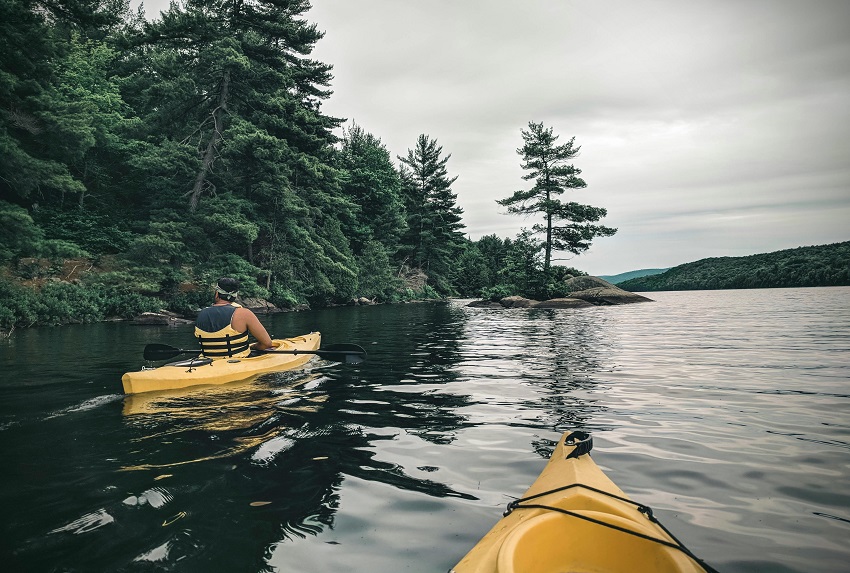
Lake kayaks are typically made out of one of four materials:
Thermoformed plastic
Thermoform plastic is a material formed from multiple layers of advanced plastic sheets (laminates) that are vacuum-wrapped around the mold of the kayak.
Because less material is used, it’s a fairly lightweight kayak, but is still very durable and inexpensive enough that it won’t drive up the price of kayaks too high.
Typically, budget-friendly recreational kayaks (such as Pelican kayaks) are made from thermoformed polyethylene and higher-end kayaks (such as Eddyline kayaks) are made from thermoformed ABS plastic.
Rotomolded Polyethylene
Rotomolded polyethylene is the cheapest material on the market, and tends to be heavy, albeit incredibly tough.
Basically, plastic pellets are poured into a hollow mold, then heated to melt the plastic and rotated so the melted plastic coats the mold. When cooled, it forms a single plastic piece that is tough and requires minimal finishing in order to be suitable as a kayak.
Fishing, recreational, and whitewater kayaks are usually made this way.
Composites
Composites like fiberglass, carbon fiber, and Aramid (Kevlar) are the higher-tech, and higher-priced, option for more advanced kayaks, such as touring and racing kayaks.
They’re incredibly lightweight compared to the two plastic types, but tend to cost more.
If you’re looking for a top-of-the-line kayak for crossing a huge lake, you may want to opt for one made of high-tech composites.
Wood
Wooden kayaks are far less common, and tend to be more of a “luxury” item, though many DIYers and traditional Native American/First Nations kayak manufacturers will use wood in the tried-and-true methods of kayak-building. Wood is naturally beautiful and can easily be assembled into a wide range of kayak designs, but requires more attention to detail and may lack the durability of synthetic materials. It’s also beautifully lightweight and has a natural buoyancy that makes them highly effective for lake kayaking.
Stability
When we talk about the stability of kayaks, there are actually two types of stability we need to talk about:
1. Primary stability, the stability of an object (in this case, a kayak) on flat, calm water.
2. Secondary stability, the stability of an object when it is tipped onto its side.
Kayaks with a high primary stability will handle best on lakes, because they are unlikely to tip over. Typically, fishing kayaks and recreational kayaks tend to have high primary stability, so when the water is calm, they will be very easy to paddle without risking capsizing.
On the other hand, kayaks with a high secondary stability will handle best on those days when the wind whips up the lake’s surface and makes it very choppy. Sea touring kayaks will be built with a high secondary stability because they’re designed to handle the dips and crests of the open ocean.
Size
When it comes to kayaks, there’s a pretty simple rule of thumb:
The longer the kayak, the more weight it can handle, and the faster it will move.
Smaller, compact kayaks (6-10 feet) are great for smaller passengers (including kids) who don’t need to carry much gear or cover long distances at high speeds.
Longer kayaks (12-16 feet) are much faster, tend to track straighter, and will be great for hauling enough gear for a multi-day paddling trip across a large lake or ferrying camping supplies over water to your campsite.
Weight
The weight of your kayak will determine how easily you can transport it A) between your vehicle and the water, and B) between bodies of water (portaging from river to lake, lake to lake, river to river, etc.).
No surprise, smaller kayaks tend to weigh less, so they’re easier for one paddler to carry, load/unload, and portage on their own. Larger kayaks tend to be heavier and may require two people to transport.
However, remember that the material also determines the weight. A 16-foot fiberglass kayak may weigh less than a 12-foot rotomolded plastic kayak.
Passengers
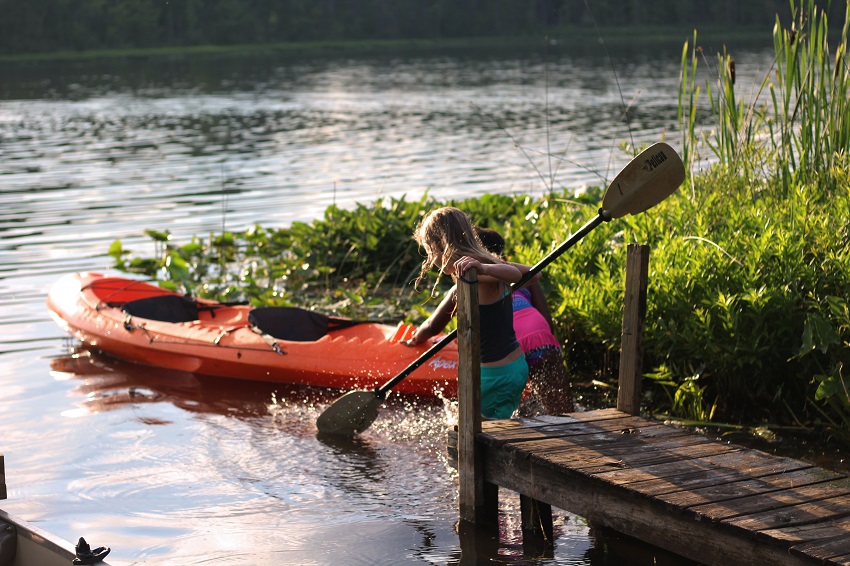
Who will be doing the paddling?
One adult. For this, you’ve got plenty of options—from fishing kayaks to touring kayaks to recreational kayaks.
One child. You may want to opt for a kids’ kayak, or at the very least, a smaller/lighter (10-footer) kayak that will be easier for them to handle.
Two adults/one adult + one child. Tandem kayaks are great for multiple paddlers, because they have two seats and are long enough that two people can paddle them together. Some are actually designed to switch between single and tandem paddling, making it easier for the adult to keep paddling alone if/when the child tires out.
One adult + one pet. Single-paddler fishing kayaks are usually stable enough to handle the weight and movement of a pet. Recreational sit-in kayaks may not have enough space in the enclosed cockpit to accommodate a pet. The heavier and more active the pet, the more primary stability and greater weight capacity you will need.
Weight Capacity
Weight capacity refers to the amount of weight the kayak can carry—not just the paddler (you), but also your extra gear.
Typically, larger/longer kayaks tend to have a higher weight capacity. For example, touring kayaks designed for multi-day travel need the ability to store enough water, food, and supplies for a few days out on the open water.
Interestingly enough, inflatable kayaks will often have the highest weight capacity. Because they are inflated with air, their buoyancy accommodates heavier paddlers and more gear.
Consider paddler weight and how much will be carried on board the kayak when looking at the ideal weight capacity of different lake kayaks.
Storage Capacity
Many kayaks (especially touring and recreational) feature enclosed, sometimes even water-tight, compartments that offer you a place to stash your gear out of the way and safe from the elements.
Fishing kayaks won’t have these enclosed compartments, but will usually be designed with features integrated into the hull to accommodate coolers, tackle boxes, and other necessary fishing gear.
How much you need to store will depend on what you’ll be doing—for example, on a multi-day trip, you’ll need to carry a lot of food, water, and changes of clothing, whereas you won’t really need much storage for a few hours exploring around the shoreline.
Paddler Skill Level
This is always a factor to consider carefully!
Experienced paddlers will be able to handle trickier, more turbulent waters, and may prefer a kayak that forgoes primary stability in exchange for greater speed and better secondary stability on open water.
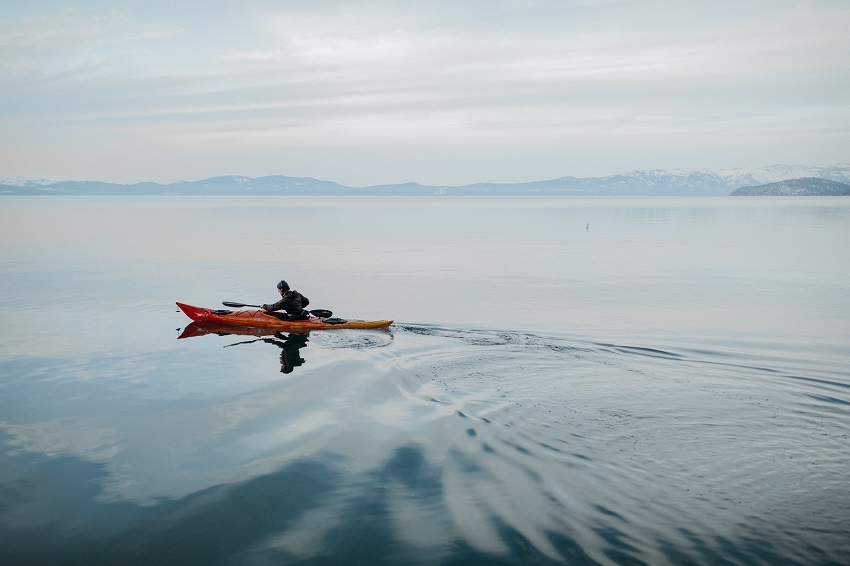
On the other hand, newbies will definitely want a kayak with higher primary stability to help make it easier to keep their balance while getting their bearings on the water.
Accessories
Most kayaks are sold without accessories—no paddle, no fishing rod holders, no PFD, just the seat and the kayak itself.
However, you can find some kayaks (especially mid and high-end kayaks) that include accessories (such as advanced multi-position seats, integrated fishing rod holders, gear tracks/mounts, pedal drives, trolling motor mounts, and more).
You’ll pay more (sometimes significantly more), but it may be worth it for higher-end accessories that come pre-installed/included with the kayak so you can get out on the water ready to fish or paddle in style.
Price
Last, but not least, you’ve got to factor in the price.
- Inflatable kayaks are the cheapest option, but also the least durable and least efficient for more challenging paddling conditions.
- Recreational kayaks can handle more paddling conditions and will be more durable, but they’re still best-suited to sticking close to the shore and paddling on calm lakes with slow-moving currents.
- Fishing kayaks will cost a bit more, but are great for anyone who wants to cast out a line and get some fishing in while the sun is high and the sky is clear.
- Touring kayaks are among the priciest options, but will be a suitable investment for advanced paddlers who are planning long-haul trips.
Best Kayaks for Lakes FAQs
The most stable type of kayak is definitely a fishing kayak. Fishing kayaks are designed not only with high primary stability, but also high buoyancy. They’re usually a hollow shell filled with air, so they sit on top of the water and provide you with a stable platform from which to fish. Many are designed even to accommodate fishing from a standing position.
Kayaks with high primary stability will flip over in choppy and turbulent waters, while kayaks with high secondary stability may be more prone to capsizing on calm, flat waters.
Sit-on-top kayaks will rarely fill with water. They are designed with scupper holes that allow water to drain out. Simply pull out the scupper plugs and you’ll never have to worry about the water filling the kayak.
Sit-inside kayaks are at risk of being filled with water. The more they fill, the more prone they are to capsizing. However, the materials used to build the kayak are lightweight enough that even when they are filled with water, they won’t sink, but float just below the water’s surface. They will be tricky to right, remount, and empty, but you rarely need to worry about your kayak sinking.
This is a rule that dictates whether it’s too cold to kayak on a lake.
The formula states that: air temperature + water temperature > 120.
If the combined water and air temperature is below 120, then it’s too cold to go paddling!
(Note: Water temperatures should ideally be at least 60 F, as much lower could put you at risk of cold water shock and hypothermia.)

